
FM 10-16
HEADQUARTERS
Field Manual
DEPARTMENT OF THE ARMY
No. 10-16
Washington, DC, 24 May 2000
GENERAL FABRIC REPAIR
Table of Contents
Page
PREFACE........................................................................................................................... vi CHAPTER 1
INSPECTING AND MARKING CLOTHING AND
TEXTILE ITEMS................................................................................ 1-1
Paragraph
1-1
Initial Inspections.................................................................................. 1-1
1-2
Final Inspections................................................................................... 1-3
CHAPTER 2
HAND SEWING ON CLOTHING AND TEXTILES.......................... 2-1
2-1
Hand Sewing........................................................................................... 2-1
2-2
Tools....................................................................................................... 2-1
2-3
Preparation of Needle and Thread.......................................................... 2-3
2-4
Hand Stitches.......................................................................................... 2-5
CHAPTER 3
MACHINE SEWING ON CLOTHING AND TEXTILES..................... 3-1
3-1
Machine Sewing...................................................................................... 3-1
3-2
Sewing Machines.................................................................................... 3-1
3-3
Tacking.................................................................................................. 3-6
3-4
Characteristics of Good Seams............................................................... 3-8
DISTRIBUTION RESTRICTION: Approved for public release; distribution is unlimited.
*This publication supersedes FM 10-16, 13 June 1984.
i
FM 10-16
Paragraph
Page
3-5
Types of Seams.................................................................................. 3-8
CHAPTER 4
REPAIRING CLOTHING AND TEXTILE ITEMS.......................... 4-1
4-1
Preparing Supplies and Equipment.................................................... 4-1
4-2
Darning............................................................................................... 4-1
4-3
Patching.............................................................................................. 4-5
4-4
Replacing Buttons............................................................................... 4-13
4-5
Remaking Buttonholes........................................................................ 4-16
4-6
Replacing Zippers................................................................................ 4-17
4-7
Replacing Hook and Pile Fastener Tape............................................... 4-23
4-8
Replacing Drawstrings.......................................................................... 4-24
4-9
Replacing Buckles................................................................................ 4-26
4-10
Repairing or Replacing Eyelets............................................................ 4-28
4-11
Replacing Snap Fasteners..................................................................... 4-31
4-12
Stitching Bindings................................................................................. 4-33
4-13
Repairing Open Seams............................................................................ 4-33
4-14
Replacing Collars................................................................................... 4-33
4-15
Replacing Patch Pocket Flaps and Belt Loops...................................... 4-35
CHAPTER 5
INSPECTING AND MARKING CANVAS AND
WEBBING............................................................................................. 5-1
5-1
Initial Inspections.................................................................................. 5-1
5-2
Final Inspections................................................................................... 5-1
CHAPTER 6
USING THE TENTAGE REPAIR KIT................................................. 6-1
6-1
Components of the Kit........................................................................... 6-1
6-2
Care of Tools.......................................................................................... 6-1
ii
FM 10-16
Paragraph
Page
CHAPTER 7
HAND SEWING ON CANVAS AND WEBBING.............................. 7-1
7-1
Hand Sewing.......................................................................................... 7-1
7-2
Preparations for Use of a Sailmaker’s Needle........................................ 7-1
7-3
Preparations for Use of a Saddler’s Sewing Awl.................................... 7-5
7-4
Hand Stitches Used on Canvas and Webbing.......................................... 7-7
CHAPTER 8
MACHINE SEWING ON CANVAS AND WEBBING.......................... 8-1
8-1
Machine Sewing...................................................................................... 8-1
8-2
Sewing Machines, Needles, and Thread................................................. 8-1
8-3
Seams...................................................................................................... 8-2
CHAPTER 9
SEWING REPAIRS TO CANVAS......................................................... 9-1
9-1
Repairing Canvas.................................................................................... 9-1
9-2
Darning................................................................................................... 9-1
9-3
Patching................................................................................................. 9-2
9-4
Replacing Stovepipe Openings............................................................. 9-28
9-5
Remaking Buttonholes.......................................................................... 9-30
9-6
Replacing Zippers.................................................................................. 9-32
CHAPTER 10 REPAIRING WITH CEMENT AND SEALER..................................... 10-1
10-1
Minor Repairs....................................................................................... 10-1
10-2
Cemented Repairs................................................................................. 10-1
10-3
Sealer Repairs....................................................................................... 10-5
CHAPTER 11 REPAIRING LINES............................................................................. 11-1
11-1
Types of Lines...................................................................................... 11-1
11-2
Knots and Splices................................................................................. 11-1
iii
FM 10-16
Paragraph
Page
CHAPTER 12 REPLACING HARDWARE................................................................. 12-1
12-1
Attaching Hardware............................................................................. 12-1
12-2
Replacing Tack-Buttons....................................................................... 12-4
12-3
Replacing Grommets........................................................................... 12-6
12-4
Replacing Snap Fasteners.................................................................... 12-10
12-5
Attaching End Clips............................................................................. 12-12
12-6
Installing Rivets.................................................................................... 12-14
12-7
Installing Tent Line Slips....................................................................... 12-16
CHAPTER 13 REPAIRING WEBBING....................................................................... 13-1
13-1
Types of Webbing.................................................................................. 13-1
13-2
Chapes.................................................................................................... 13-1
13-3
Loops...................................................................................................... 13-6
13-4
Straps...................................................................................................... 13-9
13-5
Handles................................................................................................... 13-11
CHAPTER 14 RE-TREATING TENTS AND TARPAULINS..................................... 14-1
14-1
Re-Treating Canvas................................................................................ 14-1
14-2
Re-Treating Seams................................................................................. 14-1
GLOSSARY
................................................................................................... Glossary-1
REFERENCES ................................................................................................... References-1
INDEX .............................................................................................................. Index-1
iv
FM 10-16
PREFACE
SCOPE
This field manual is a guide for fabric repair specialists, personnel qualified in MOS 43M, grades E1
through E7. It can be used by personnel in both mobile and fixed repair units. This manual consists of general instructions for the inspection and repair of military clothing, textiles, canvas, and webbing. It covers methods for sewing by hand and by machine. It includes directions for different kinds of stitches, seams, darns, and patches. It explains how to replace fasteners (zippers), and hardware items.
Publications which pertain to fabric repair are listed at the back of the manual.
USER INFORMATION
The proponent of this publication is HQ TRADOC. Send comments and recommendations on DA Form
2028 (Recommended Changes to Publications and Blank Forms) directly to :
Training Directorate
Quartermaster Training Division
ATTN ATCL AQ
401 1ST Street
Fort Lee, Virginia 23801-1511
Unless this publication states otherwise, masculine nouns and pronouns do not refer exclusively
to men.
v
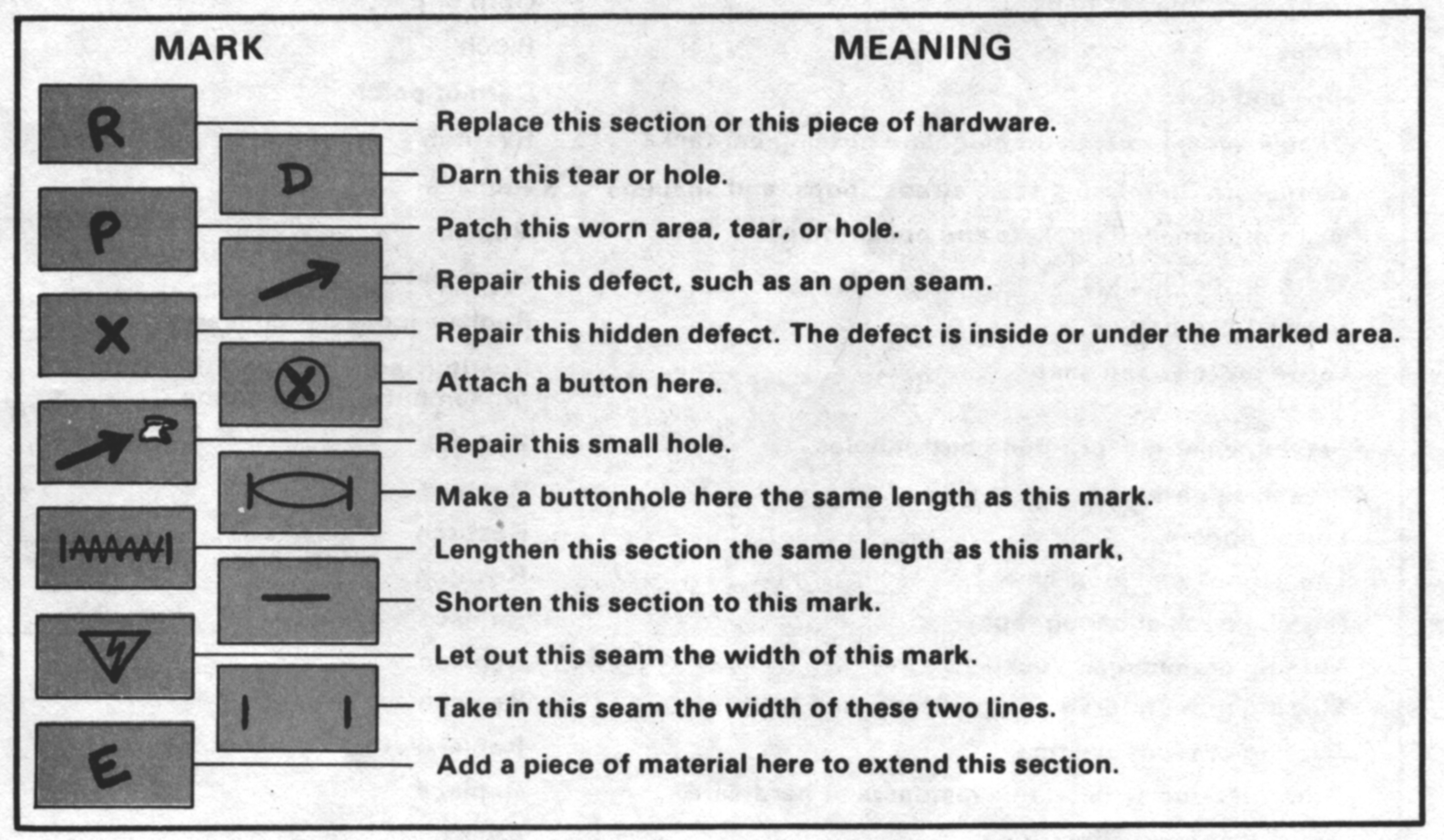
FM 10-16
CHAPTER 1
INSPECTING AND MARKING CLOTHING AND TEXTILE ITEMS
1-1. INITIAL INSPECTIONS
When damaged clothing and textile items are received in a fabric repair shop, they are inspected. These inspections determine if the pieces of clothing and equipment can be economically repaired in the shop and then reissued. The individual items are classified by condition. Faded clothing, noticeably stained items, and defective items which cannot be repaired or are not worth repairing are set aside. These items are used for scrap or for duties that damage clothing, such as painting. Items to be mended are marked with white or yellow tailors clay chalk. See Figure 1-1 for the symbol and meaning of each mark used during the inspection of clothing and textile items. Table 1-1 lists the areas marked by the initial inspector.
Figure 1-1. Chalk marks used on clothing and textile Items.
1-1
FM 10-16
Table 1-1. Areas Marked in Initial Inspection of Clothing and Textiles
DEFECT
REPAIR
Worn fabric, especially in knee, crotch, seat, elbow, and
underarm areas
Patch
Frayed edges, especially on hems, cuffs, collars, fly
fronts, and pocket flaps
Darn or patch
Holes
Patch
Rips and tears
Darn or patch
Open seams, broken stitching, and missing bar tacks
Restitch
Worn, torn, or missing tabs, straps, loops, and epaulets
Replace
Worn or damaged pockets and pocket flaps
Replace
Worn or torn linings
Darn, patch, or replace
Missing padding
Replace padding and restitch
Loose buttons and snaps
Restitch and replace missing or broken
buttons and snaps
Frayed, enlarged, or ripped buttonholes
Remake
Broken zippers
Replace
Loose zippers
Restitch
Loose hook and pile fastener tape
Restitch
Missing hook and pile fastener tape
Replace
Missing or damaged buckles
Replace
Missing or worn drawstrings, laces, and belts
Replace
Missing or worn elastic
Replace
Other missing or defective fasteners or hardware
Replace
Areas that need alterations
Resize
1-2
FM 10-16
1-2. FINAL INSPECTIONS
After repairs are completed, pieces of clothing and textile items are inspected again. Each item is carefully examined to make sure all repairs were done and that no defects were overlooked. The quality of repair work is also checked during this inspection. Each repair is examined to make sure the correct size and color thread, type and length of stitch, and type of seam were used. Breaks in stitching are checked to be sure they were tacked. Patches are inspected to be sure that they were installed correctly and that they match the color, texture, and weight of the fabric. Replaced parts such as zippers, snaps, and buttons are examined to make sure that the correct type and size were used and that they were attached correctly. Each item is also checked to make sure that a fabric repair specialist has not sewn together two pieces of fabric that should not have been joined. Items that pass inspection are reissued.
Items that do not pass inspection are marked and returned to a fabric repair specialist for corrections.
1-3
FM 10-16
CHAPTER 2
HAND SEWING ON CLOTHING AND TEXTILES
2-1. HAND SEWING
Hand sewing is stitching done manually with a needle and thread. It is used when very fine or delicate work is necessary. For all other work, machine sewing is used as much as possible. Sewing by hand is done only when the item is too small or too large to repair by machine, or when the area to be repaired will not fit under the machine needle or presser foot.
2-2. TOOLS
The tools needed for hand sewing are few and simple. They are all shown in Figure 2-1 and described below.
a. Shears or Craftman’s Knife. Shears (1) are used to cut the fabric and thread. Their handles are also used to put a crease in a piece of fabric. Sharpen the points and edges regularly to make cutting easier and more accurate. Lubricate the screw when necessary, and wipe the shears clean. Do not use shears to cut anything heavier than fabric, because it will dull the blades. Craftman’s knives (2) are used to rip out stitching and to open or lengthen buttonholes. Tighten the blades when they are loose. Replace the blades when they become dull.
b. Pins, Needles, and Thimbles. Straight pins (3) are used to hold two or more layers of fabric together during sewing. Needles (3) are used to pierce fabric and to pull thread through cloth to make stitches. Needles come in various sizes. Some may have longer eyes. Use only clean, sharp needles and pins. A thimble (3) is a metal cap which is placed over the middle finger of the sewing hand to protect the finger and to make it easier to push the needle through heavy material or several layers of fabric.
Although a thimble is awkward to wear, its use is encouraged to prevent injuries.
c. Thread. Thread (4) is used to sew two or more layers of cloth together. It may consist of a single strand called a ply or several strands which have been twisted together to make a stronger thread (Figure 2-2, page 2-3). A two-ply thread consists of two strands, a three-ply thread consists of three strands, and so on. Thread is made of cotton, nylon, or polyester. It comes in various colors and weights.
To mend an item, use the same color and type of thread that was used to make the item.
d. Ruler or Measuring Tape. A ruler or measuring tape (5) is used to gage accurately the length and width of seams and hems.
e. Tailor’s Clay Chalk. During inspections, yellow or white tailor’s clay chalk (6) is used to mark defects. During sewing operations, it is used to mark seam-stitching and hem-stitching guidelines on cloth.
2-1
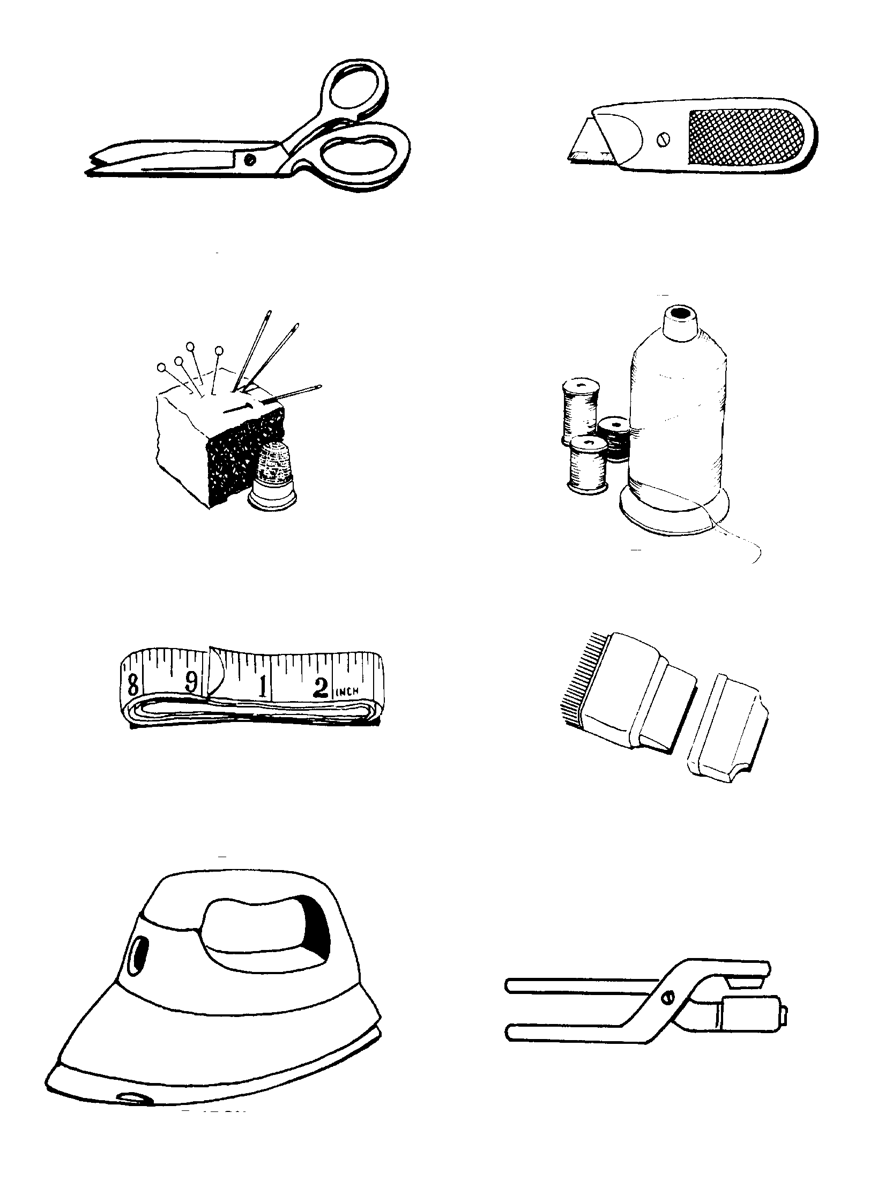
FM 10-16
1. SHEARS 2. CRAFTSMAN’S KNIFE
3. PINS, NEEDLES, AND THIMBLE
4. THREAD
5. MEASURING TAPE
6. TAILOR’S CLAY CHALK
8. BUTTONHOLE CUTTER
7. IRON
Figure 2-1. Sewing tools
2-2
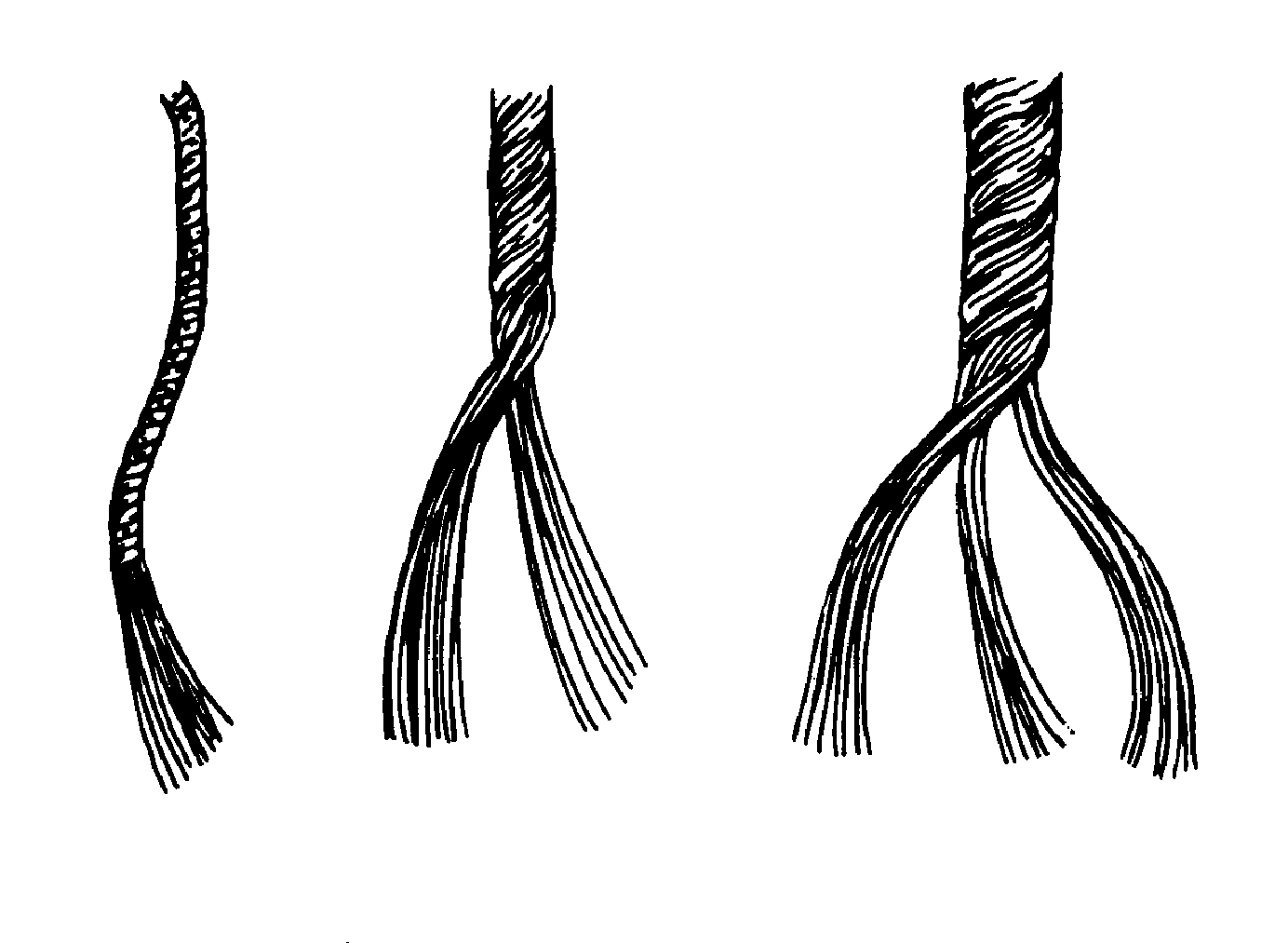
FM 10-16
Figure 2-2. Single-ply, two-ply, and three-ply thread
f. Iron. An iron (7) is used to press open seams and press down folds to make sewing easier.
g. Buttonhole Cutter. A buttonhole cutter (8) is a hand-held device used to cut slits in cloth for buttonholes.
2-3. PREPARATION OF NEEDLE AND THREAD
Threading a needle and making a knot in the thread (Figure 2-3) takes nimble fingers and good eyesight.
It gets easier with practice. Procedures to thread a needle and make a knot are described below.
a. Using shears, cut a piece of thread about 36 inches long from a spool. Do not attempt to break the thread manually or to bite through it. This frays the end and makes it more difficult to get the thread through the eye of the needle. Do not cut a piece of thread any longer than 1 yard. Thread that is too long tangles and knots.
b. Hold the needle in one hand, and grasp the thread about 1/2 inch from the end. To see the eye more easily, hold the needle up to light or against a light background. Stick the end of the thread through the eye of the needle.
c. If sewing with a single thread, feed or pull 5 or 6 inches of thread through the eye, and knot the other end. If sewing with a double thread, pull one end of the thread through the eye until both ends are even, and then knot the ends together.
d. To make a knot, first make a loop by wrapping the end of the thread once around the tip of the forefinger. Slide this loop off the fingertip with the thumb, and pass the end of the thread through the loop. Grasp the end of the thread, and pull the knot taut to set it. To make a larger knot, repeat this step and adjust the thread so that the second knot lands on the first one.
2-3
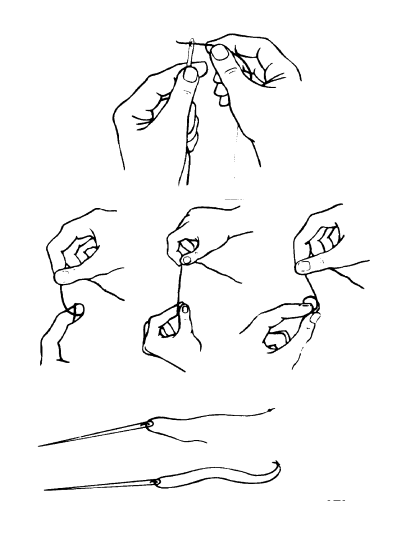
FM 10-16
SINGLE THREAD
DOUBLE THREAD
Figure 2-3. Threading a needle and making a knot
2-4
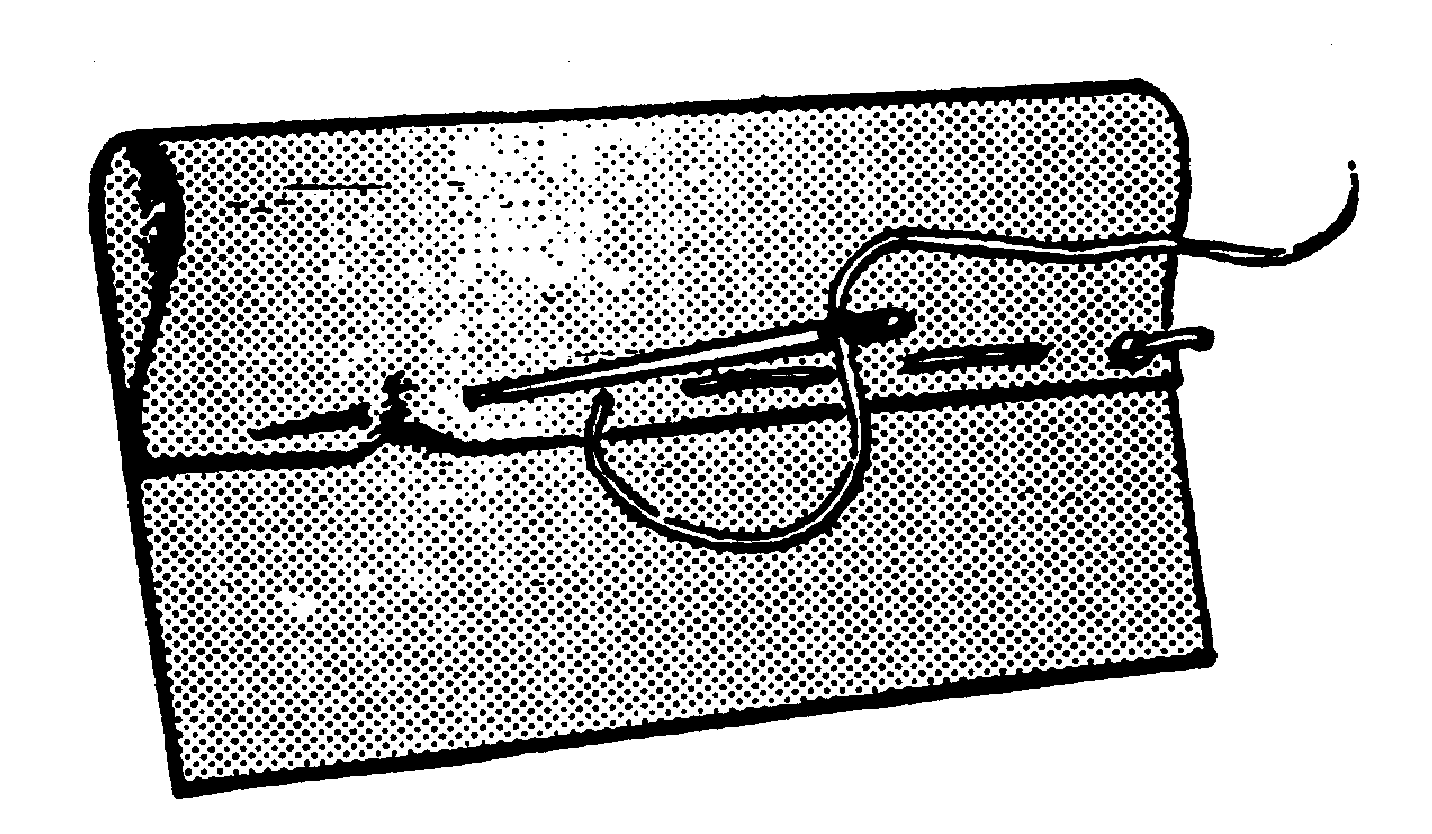
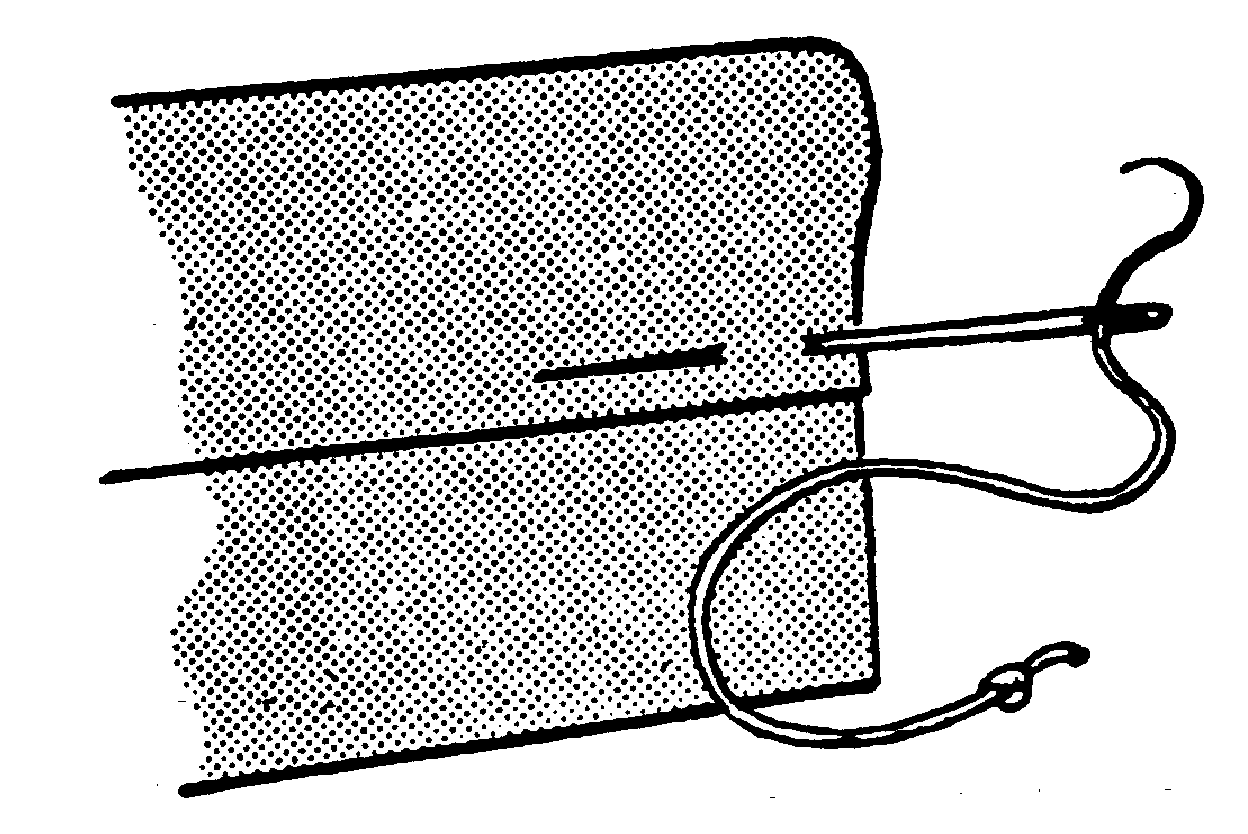
FM 10-16
2-4. HAND STITCHES
There are dozens of stitches that can be sewn by hand. A variety of hand stitches are used to mend military clothing and textile items.
a. Basting Stitch. The basting stitch (Figure 2-4) is very common in tailoring. Before any
permanent stitches are put into a garment, a temporary stitch is put in to hold the material in position or to see if the garments will fit the individual properly. To make a row of basting stitches--
(1) Thread the needle with a contrasting color of thread so the stitches will be easier to
see and remove later.
(2) Stick the needle through the cloth, and pull the thread through the cloth to the knot.
(3) Stick the needle into the cloth, and weave the needle in and out of the cloth several
times. Stitch alongside, instead of directly on, the line where the permanent stitches will be sewn. Make the stitches two or three times longer than running stitches.
(4) Pick up as many stitches as possible before pulling the needle and thread through the
cloth. Continue to stitch to the end of the row.
(5) Make a knot in the thread close to the cloth, and cut off the remaining thread.
(6) After the permanent stitch has been placed into the material, the basting stitch is then
removed.
(7) The length of the basting stitch depends on the work that has to be performed. If the
stitch is placed on the collar of a jacket, many stitches are needed to hold the material in place, but on the legs of trousers when they are being hemmed, only a few are needed and they can be placed a reasonable distance apart.
A
B
Figure 2-4. Basting stitch
2-5
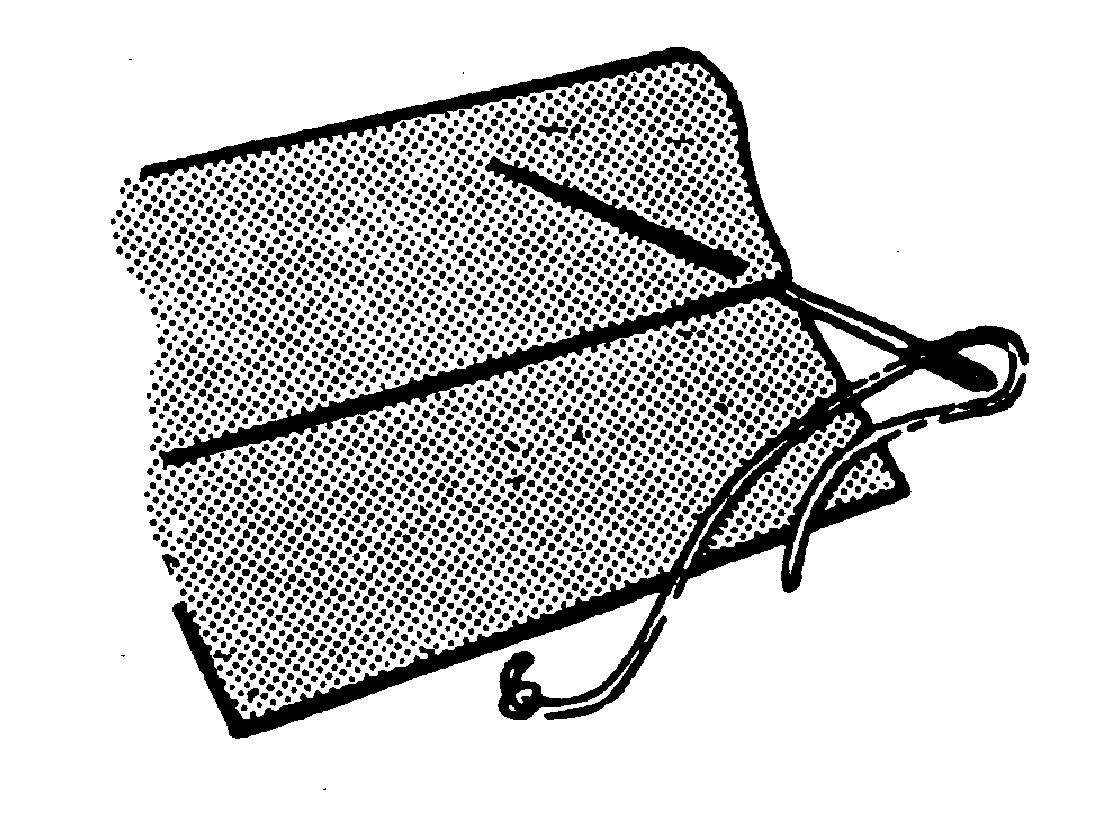
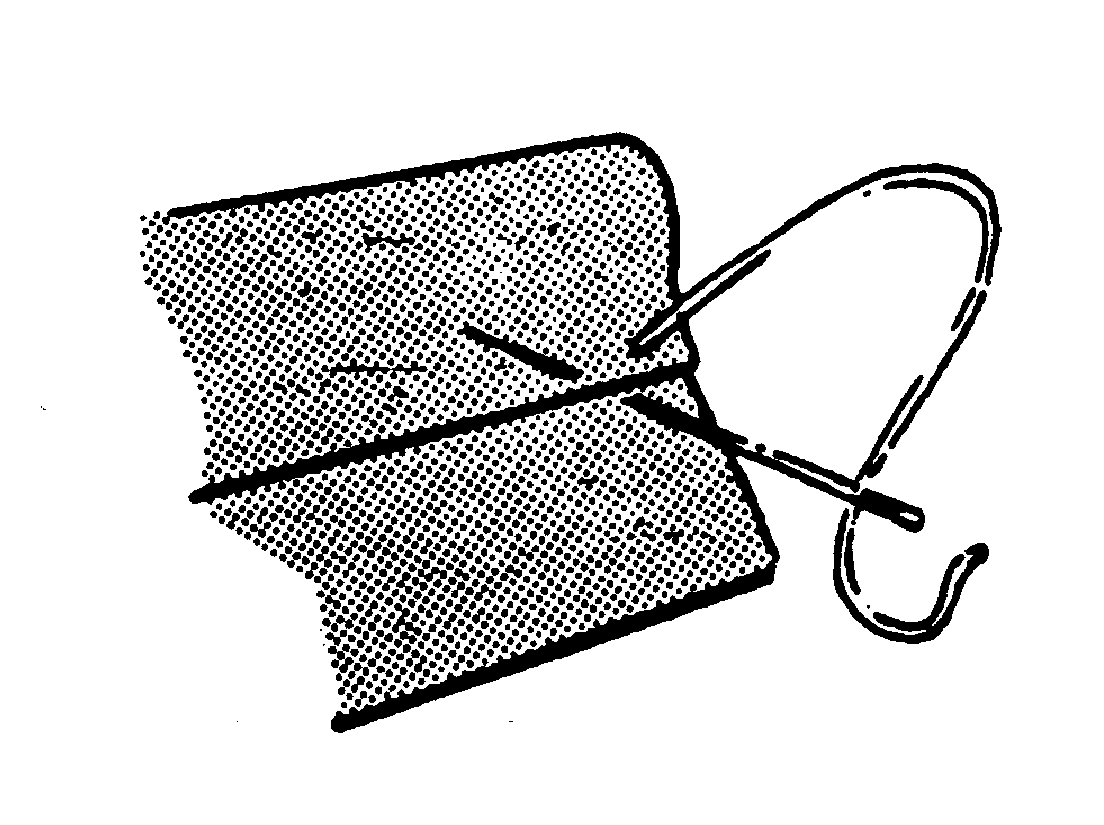
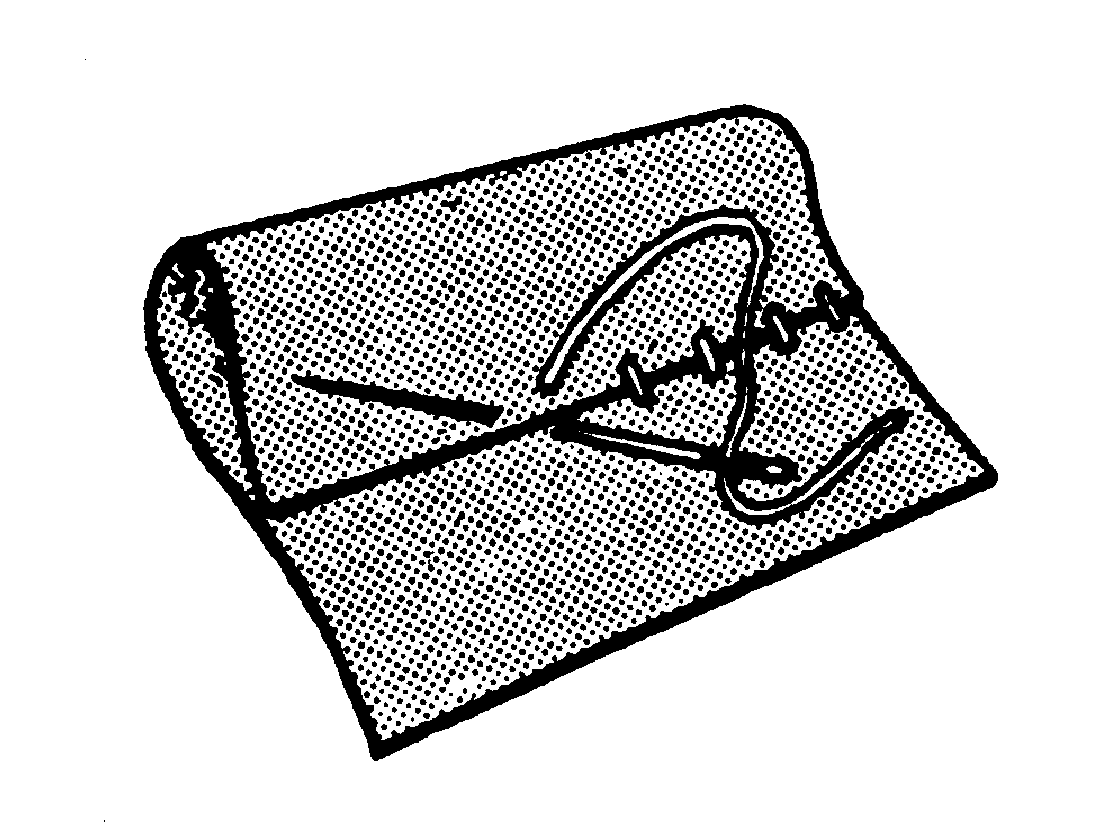
FM 10-16
b. Felling Stitch (Vertical Hemming or Overhand Stitch). The felling stitch (Figure 2-5) is a
form of blind stitch used in most instances to hem or to hold two pieces of material together where a machine cannot satisfactorily operate, for example, sleeves on wool jackets. It is possible to sew the lining by machine; however, the machine sewn stitch through the sleeve would not present a neat military appearance. In some cases, the waistband on trousers are felled in by hand. The felling stitch can be used only on smooth edges where no thread has become unraveled. The rough edges of the fabric is turned under before stitching. The length of the felling stitch is determined by the job it has to perform; normally, the felling stitches should be 1/8 of an inch apart, depending on the type of work to be done.
A
B
C
Figure 2-5. Felling stitch
c. Cross Stitch (Catch Stitch). The cross stitch (Figure 2-6) is used to sew raw edges of material to keep it from raveling, as in hems. Cross stitches are blind stitches used in most instances to hem 2-6
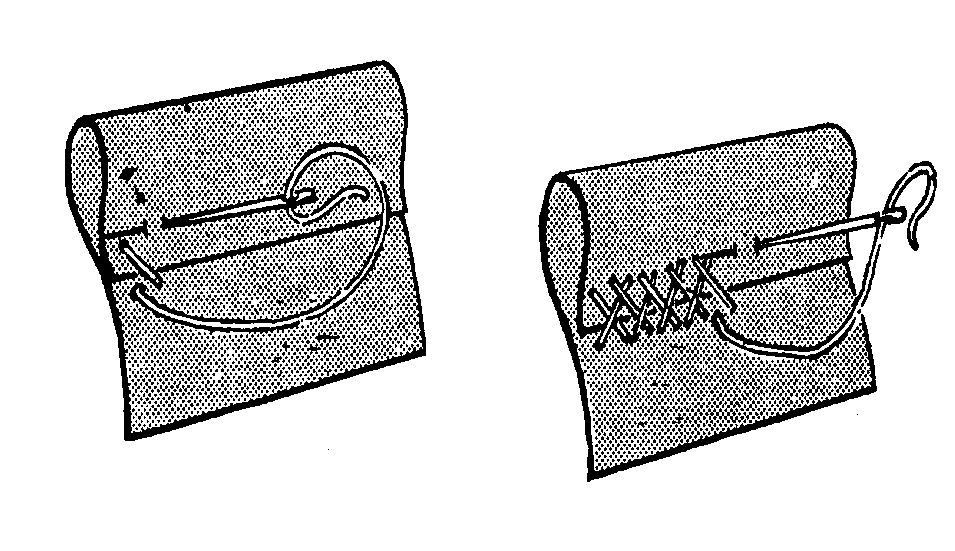
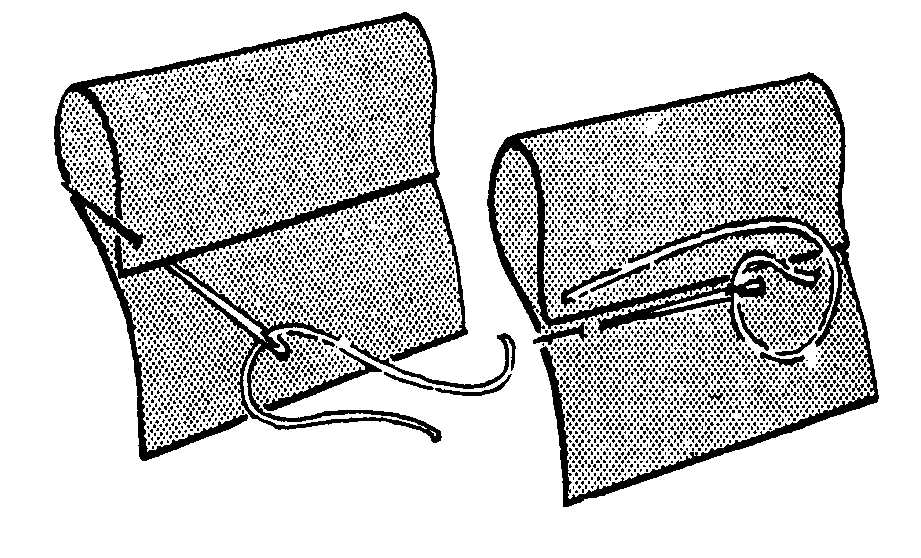
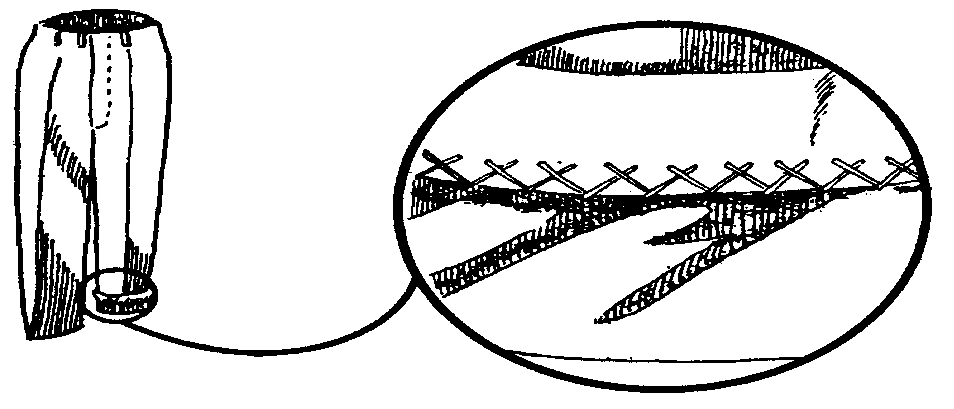
FM 10-16
trouser legs and places where a blind stitch is necessary and a machine cannot satisfactorily operate.
Cross stitches should be smooth, even, and completely hidden on the right side of the material. To make a row of cross stitches--
(1) Stick the needle through the cloth, and pull the thread through the cloth to the knot.
(2) Backstitch to tack the row at the beginning.
(3) Make a long diagonal stitch across the raw edge of the hem, and stick the needle into
the fabric of the garment. Securely catch the fabric, but do not penetrate it completely.
(4) Take a small horizontal stitch back in the fabric of the garment.
(5) Make a long diagonal stitch across the raw edge of the hem so that the thread crosses
over itself, and stick the needle into the fabric of the hem. Penetrate the fabric of the hem
















